Neuros OSD Video Station and Media Centre Review
Neuros OSD Video Station and Media Centre
Neuros' revolutionary Open Source Device lets you help its evolution.
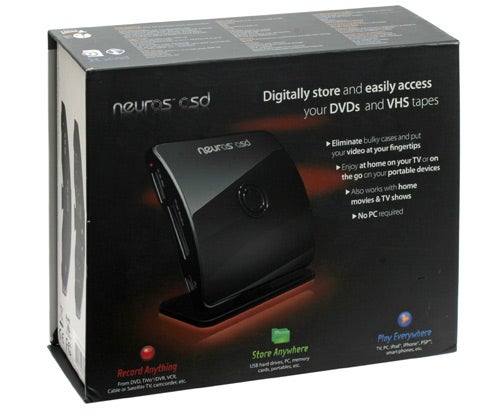
Verdict
Key Specifications
- Review Price: £134.95
Like everything else about the Neuros OSD, its name is deceptively simple. Neuros is the company name, while OSD stands for Open Source Device. You see, the Neuros is actually running a custom form of Linux, and the company has not only left the software open for customisation, but has released full details on all the hardware specifications, to make it as easy as possible to program for. The one potential problem is that no matter how ingenious, code creators will be limited by the existing hardware. But even on this front, Neuros is a bit more open than usual, with the occasional hardware upgrade or revision already having improved the device in several areas since its market debut.
As Firefox proves, open source can be incredibly successful. It’s a simple concept, and as long as your project can garner some sustained interest from the community, you get an incredibly flexible and ever-evolving product at little or no software-development cost to the manufacturer. It has been done before, but never on a product like this, and Neuros deserves nothing but praise for the idea.
Before we get into the software side of the Neuros OSD, let’s see how the hardware holds up. We don’t usually mention a product’s packaging, but in this case I’m willing to make an exception. The box it comes in is a lovely affair made from thick, high-grade cardboard, with full colour, laminated pictures. What is more, the clasp keeping it securely closed is magnetic – hmmm, magnetic. Anyway, getting onto the contents, you get a full-colour quick start guide with a ”lot” of text, the unit and its stand, a remote control with batteries, two SCART to composite adapters, two 3.5mm to composite cables, a mini 2.5mm jack to serial cable for altering the firmware programming, mini jack to IR extension cable (or IR blaster), and a power adapter. 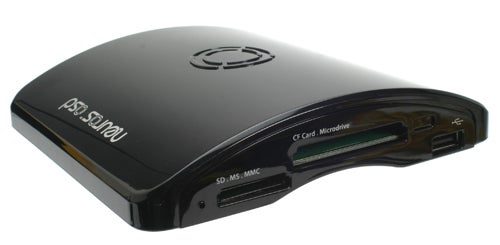
Following on from the stylish box, it certainly doesn’t hurt that the device itself looks pretty good. It may feel slightly flimsy, and it does wobble a bit when you put it down on its thick rubber pads, but it’s not what I’d call an eye sore – especially when you attach it to the included stand, which is a simple matter of clicking it in. Naturally, the stand also has protective pads, and thankfully doesn’t wobble.
The Neuros sports a glossy piano black finish. Unfortunately, since it’s constructed using inexpensive plastic, the finish scratches easily, and dust and fingerprints are far more obvious than one might want. But as long as you’re very careful with it, its curved shape and diagonal orientation when attached to its stand make it attractive enough that it wouldn’t look out of place beside your other AV kit.
On one side of the device you’ll find all the cable inputs, including LAN and S-Video in, while the other side features a small green LED that can be difficult to see, but by the same note is quite unobtrusive. There’s a single powered USB port, meaning you can connect 2.5in external hard drives without a power supply or charge devices like your iPhone while streaming video from or to it. I’m just slightly disappointed that Neuros hasn’t seen fit to include a second one, for copying between USB storage devices if nothing else. It does somewhat make up for that by supporting a prolific selection of memory cards: CF, MicroDrive, MMC, MemoryStick Pro/DUO and – though both the manual and the box only display SD Card compatibility and the site specifically states you need a separate adapter – it worked fine with a 16GB Kingston SDHC card.
In a thoughtful touch, the included black remote control is actually a universal model that you can also use to control other devices like your TV or DVD-player. Unfortunately, unless your other devices use bricks teleported over from the 1980s for remotes, you really won’t want to. Okay, so that might be exaggerating a little; the remote is workable. But it’s also slightly uncomfortable to hold, with cheap, clunky buttons and not the best layout. However, it’s no less of a great idea to include a universal remote with a device like this, especially since it’s a given that most people who get it will already own a few. And a bit of ergonomic discomfort is probably not too high a price to pay for the convenience of having everything in one, despite limited operating range being another of the remote’s weak points. 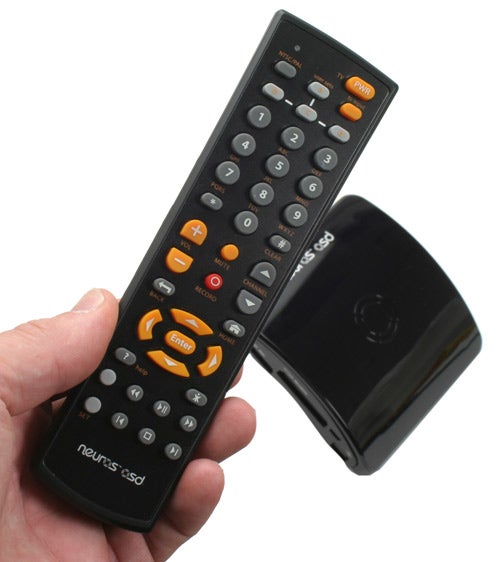
A quick word about power usage: there is no way of switching the Neuros OSD off. Neuros claims “there really is no downside to leaving it on ALL the time. The OSD draws little to no power when it is not being used and the heat generated by the OSD is negligible”, but it would help if Neuros mentioned what this ‘negligible’ amount of electricity actually is. So of course we measured it, and the OSD posted a minimum usage of 3.3W while idle. Not the end of the world, but hardly negligible in today’s environment of stringent energy saving, so you might want to get a switched plug extender.
But let’s get to what is the most interesting thing about the OSD; its ‘open source’, programmable software and interface. I can see why Neuros doesn’t recommend turning the device off, since it takes just over a minute to boot up. If you do leave it always on though, this obviously isn’t a problem. After a quick date/time settings screen on first use, you’re greeted by the main menu, which is actually rather bland. Grey text – which becomes white when highlighted – against a default black background hardly makes for a visual feast. Things improve once you hook up an active recording source, as the Neuros OSD will display that content as its background.
The main menu is logical and sensible. There’s a Getting Started entry, which is basically an extended version of the quick-start guide, meaning it’s easy to learn all you need. Even better, if at any stage you are confused about a particular menu entry’s function, just press the ‘help’ button on the remote, which will bring up a handy and specific explanation. Unusually, Record/Schedule is above Play/Browse, followed by Settings and More Applications. I dived straight into the settings menu without looking at the quick-start guide and, though you do have to trawl through a load of entries, the lack of submenus means everything is easy to find – eventually.
Of course the first place I headed after setting the Neuros up was Firmware Upgrade. A quick detour to Network to get it to recognise our LAN setup later, the OSD endeared itself to me tremendously by showing a retro pong game during the firmware update. That’s the thing about homebrew; it can ”potentially” be far more inventive and charming than its rigid ‘professional’ counterparts. To my disappointment, the update did not activate the Samba Server firmware functionality, which should turn the Neuros into a NAS (Network Attached Storage) box, and was mooted for the fourth quarter of last year. 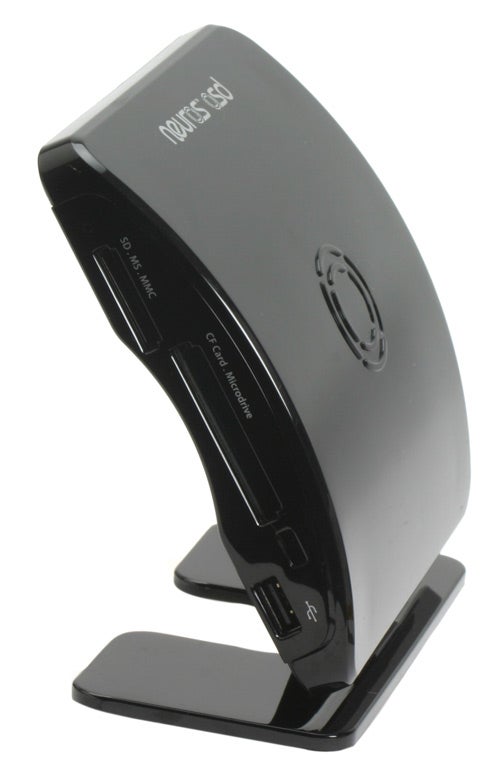
Let’s look at some of what the Neuros OSD can be used for in the meantime. Right now it’s still fairly similar to any other media box out there, save for its interesting recording abilities and a few unique features. Of course it can act as a photo viewer, music and video player, but in addition you can also stream music and watch YouTube videos directly from the Internet – sorted by time, popularity or category – without needing a PC. This is a user-added feature which, just like the as-yet unimplemented NAS functionality, was in the pipeline for a while, but is now fully realised and works rather well. More importantly, it goes to show how flexible the OSD can really be.
For now, until someone programs it to make tea for you while teaching you Japanese, the most interesting aspect of the Neuros is its recording ability. The headline feature on the front of the box is that you can “digitally store and easily access your DVDs and VHS tapes”. Well, yes, but it’s not as straightforward as it sounds. What the company means is that its device will let you record ”any” source that offers composite or S-Video out. And while this does make it very flexible indeed, you’re not only getting SD content, you’re getting it over two poor quality analogue connections available.
If you know enough to be reading this review, you’ll probably be able to figure out how to rip DVDs from your PC onto an external hard drive, which will of course give you far better quality. One of the potential barriers to this is that you might be one of those few people who don’t actually own a computer with a DVD drive – but are you really likely to spend £135 on a media station instead of a computer upgrade under these circumstances?
Realistically, only those who care enough about their VHS collection to re-record all of it in real time – or those who really don’t care that much about quality in the first place – would consider the OSD, were it not that the it has a few more tricks up its sleeve. Though again it’s nothing you couldn’t easily convert using a PC, you can set the Neuros OSD to record for a PSP, iPhone or Smartphone, which will automatically choose the appropriate resolution for the device. After all, image quality is much less of a concern when you’re watching material on a 4.3in screen. For TV recording, meanwhile, the OSD can do 640 x 480 or a rather odd but more widescreen-friendly 672 x 448 in MP4 format – just keep in mind that when recording at these resolutions, there is a 4GB maximum file size. For audio recording, the Neuros can do AAC or MP3.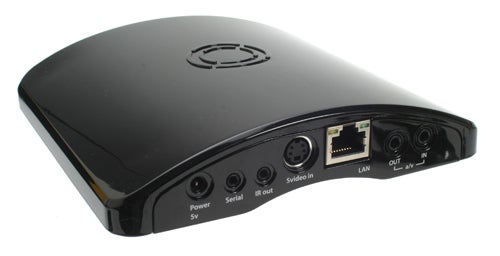
The recording process is easy as pie. Anyone who can manage a VCR will have no trouble whatsoever with the Neuros – to a point. You see, there is absolutely no mention in the quick-start guide of how to prepare your media. Considering it spends an entire page on recording settings, which are rather easy to figure out, this is a regrettable lack. FAT or FAT32 file systems are readable, but the OSD can’t cope with NTFS. So yes, you can plug in your 1TB hard drive, but you might need to re-format and partition it first. 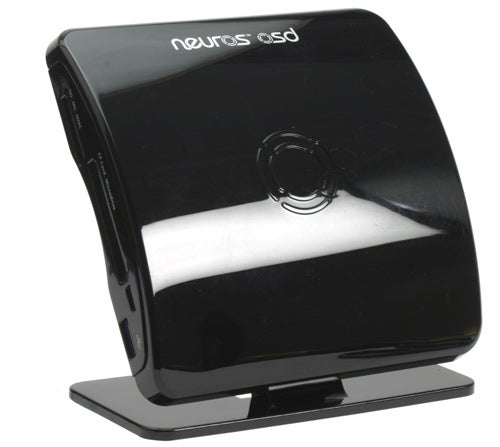
The main thing holding the Neuros OSD back is its somewhat limited hardware and lack of support for high definition. I can understand Neuros not wanting to get involved in the whole DRM/licensing nightmare that an HDMI input would represent, but an HDMI output would at least give you better picture quality when viewing. At the very least give us component – it’s an analogue standard with no copy protection so recording from it should be just as easy, and it would certainly improve output quality – especially for DVDs. Also, with the world’s most successful current generation console, Nintendo’s Wii, not to mention all the older Xbox 360s and upscaling DVD players using it, it’s hardly likely to get killed off by digital anytime soon. If Neuros was to make an Open Source Device with more ports and high-definition support, then the possibilities would be amazing, and I would buy one in a flash.
”’Verdict”’
The Neuros OSD has a lot of potential, but doesn’t quite deliver enough to make it worth the asking price. It does what it says on the box, but unless you’re not too concerned with video quality, you still cherish your video-cassette collection, or you don’t own a PC, we wouldn’t recommend it. Once – or ”if” – the NAS functionality is implemented, the device will become a lot more interesting, and of course due to its open source nature, other enhancements are always possible.
Trusted Score
Score in detail
-
Value 5
-
Features 6
-
Design 7

